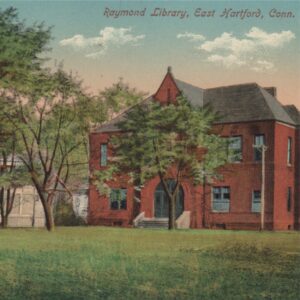
Jason Pannone – Albert C. Raymond (1819 – 1880)
Albert C. Raymond was born in 1819 and raised in his hometown of Montville, CT. By 1840, Raymond was a successful farmer and business man. In that year he married Esther Roberts.
Esther’s father, Ozias, was the patriarch of the Roberts clan, and a direct descendent of one of the founding families of first Hartford and then East Hartford. With this marriage to the daughter of a prominent and much respected citizen of the town and region, Raymond immediately became part of the local establishment.
After living for a time in Hartford, Albert and Esther moved into their newly built East Hartford residence in 1874. The house is a large Victorian Italianate house on the corner of Main Street and Central Avenue. The house still exists, but now is a Masonic Hall with most of its elaborate and elegant detailing sadly gone, along with its coach house and other out buildings.
Childless, Raymond and his wife became involved citizens and generous benefactors of their beloved town. Elected in 1869, Albert served one term in the state’s House of Representatives. In 1878 the Raymonds’ donated a clock and new bell for the tower of the Congregational Church.
The Raymond Library was by far the most important and lasting example of their public generosity. In 1879 they donated a piece of land to the town as both a public park and future site for a library, the first of each for the town.
The lot was deeded to the newly chartered Village Improvement Society, part of a national movement of the second half of the 19th century dedicated to the sprucing up and care of small-town centers.
Its costs underwritten by Raymond, the library was built in 1889. Designed by Hartford architect, William C. Brockelsby, it was clearly influenced by the then popular Richardsonian Romanesque style. Created by the most influential American architect of his time, H. H. Richardson of Boston, the style is an American version of the Victorian Romanesque Revival style.
Raymond formed and funded the Raymond Library Company as owner and guardian of both the library building and the park on which it sits. These in turn are leased to the town in perpetuity, which, for its part oversees the staff, books and other media, and day-to-day maintenance.
Interestingly, the Raymond Library is part of a group of small public libraries of New England donated by patrons such as Mr. Raymond for the improvement of their towns, and that collectively make a coherent reflection and statement of the Richardsonian Romanesque style.
In viewing each library one sees a facade clearly defined by its use of the rounded arch, minimal ornamentation, and harmonious balance of weight and mass. As such, these influences of the Richardson Romanesque unite these libraries architecturally, giving these and other public buildings built in this style the stature and substance to be taken seriously and treated with respect.
Remarkably subsequent additions to the Raymond Library, none more than that of 2015, were sensitive to its original architectural concept and the need for remaining true to it. Its original, inherent, solemnity gracefully allowed nonetheless for its institutional gravitas to embrace the vitality and engagement so necessary to being part of the community fabric of its time and into the present day.